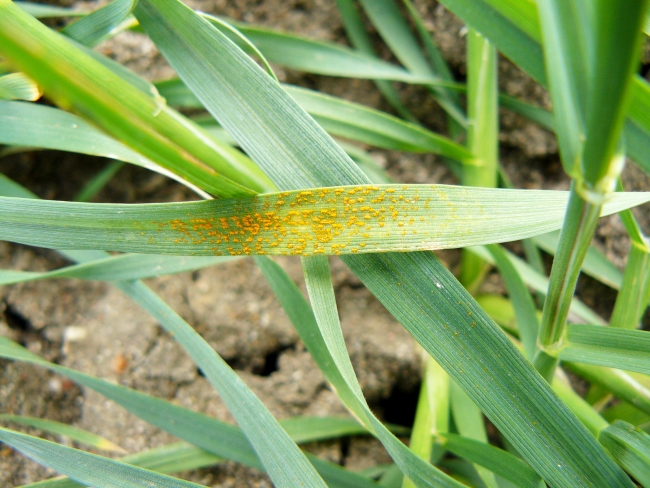
Growers across much of the northern grains region have been challenged by significant infections from stripe rust in wheat this season. While many had experience with this disease in 2020, the issue was generally concentrated to a few varieties, particularly DS Bennett, Scepter and durum varieties such as DBA Lillaroi. What has been observed in 2021 has challenged management decisions with varieties reacting differently and, in some situations, multiple fungicide applications being required to manage the disease, or varieties being sprayed that have never been sprayed before. Growers and agronomists alike are asking how they could have been better prepared for the stripe rust epidemic this year, and in the lead up to harvest they are questioning, how they make sound variety choices for 2022 and beyond.
Professor Robert Park, Director of Cereal Rust Research at The University of Sydney and NSWDPI pathologist Dr Steven Simpfendorfer have responded to the most frequently asked questions about stripe rust from this season in an effort to help explain "why we saw what we saw and how growers can be better prepared in 2022".
Key points
- Stripe rust epidemics were seen in 2021 across much of northern grains region.
- Good cropping years are usually also good for rust infection. The green bridge, an early start to stripe rust infections and mild conditions allowing for additional rust lifecycles, have all led to higher inoculum and infection.
- Slow crop development in mild conditions left some crops unprotected between typical management growth stages and delayed onset of adult plant resistance.
- Varietal resistance can vary considerably between the key pathotypes (strains) of stripe rust and there was an increased distribution of the 239 pathotype which resulted in some unexpected varietal responses.
Why was there a problem?
What were the environmental conditions that contributed to stripe rust infections this season?
Good cropping years are usually 'good' (i.e. bad) rust years! These pathogens make a living off live plant tissue, so the more vigorous plant growth is, the better the substrate for rust pathogens. Typically, vigorous plant growth occurs in years with good moisture, which is also conducive to rust infection.
At least six hours of leaf wetness is needed for a stripe rust spore to germinate and infect the leaf blade. Once established, further disease progression is purely dependent on temperature. The optimum temperature range for stripe rust development is 12-20°C. At these temperatures it will take 10-14 days for a fresh batch of spores to emerge from infected leaves. This is called the latent period, during which time stripe rust infection within leaves is not visible. Temperatures above or below this optimum range DO NOT kill the pathogen. Rather the fungus slows and can become dormant outside these temperatures, but importantly will continue to develop once temperatures return to the optimal range. Hence, the more time in a 24-hour period between these optimum temperatures, the shorter the latent period. Conversely, as temperatures normally warm in Spring the stripe rust fungus stops developing during the day once above 22°C but continues again overnight as temperatures drop. In these circumstances, the latent period extends to a 20+ day cycle time.
Consequently, the frequent rainfall and extended mild temperatures well into Spring across much of the northern grains region in 2021, has favoured infection and multiple lifecycles of stripe rust. These conditions have created an extremely high pressure season for stripe rust across this region.
Did slow crop development change how the disease impacted and does nutrition play a role?
Seasonal conditions not only affect the stripe rust pathogen, they also affect crop development and expression of resistance genes in different wheat varieties. Most varieties rely on adult plant resistance (APR) genes for protection from stripe rust, which as the name implies, become active as the plant ages. Consequently, all varieties, unless rated resistant (R), are susceptible as seedlings and move towards increasing resistance as they develop and APR genes become active. The growth stage at which APR becomes active differs between wheat varieties and relates to their resistance rating. An MR variety would generally have APR active by GS30-32 (early stem elongation), MR-MS by GS37-39 (flag leaf emergence), MS by GS49-60 (awn peep-start of flowering) and MSS by GS61-75 (flowering to mid-milk). Varieties rated S or worse have relatively weak levels of resistance that are generally of limited value in disease management. Note that a variety can have a higher or lower resistance rating to individual pathotypes (aka strains) of the pathogen, depending on its resistance genes and the corresponding virulence of different stripe rust pathotypes.
Mild temperatures during 2021 that extended well into Spring slowed crop development, which consequently delayed the expression of APR genes whilst also favouring multiple lifecycles of stripe rust infections. This extended time between growth stages also affected management strategies, which in more susceptible varieties is based around early protection with fungicides until APR within a variety is reliably expressed.
For example, in MS varieties a two-fungicide input strategy normally provides effective management of stripe rust, with flutriafol on starter fertiliser or in-crop fungicide application at GS30-31 being the first input, followed by a second fungicide application at GS39. This strategy relies on extended control of in-furrow flutriafol (normally out to GS37-39) or approximately three-weeks leaf protection from a foliar fungicide applied at GS30-31. With a two-spray strategy the GS30-31, application provides three weeks protection of the Flag-2 leaf and lower leaves to limit stripe rust development in the canopy. Over the next four to five weeks, the Flag-1 and Flag leaf will emerge and be unprotected (but should also be under low risk of disease due to the first fungicide application). A second application at full flag emergence (GS39) then provides a further three weeks protection of the top three leaves, so that when the heads emerge in four to five weeks and APR becomes active, there has been little opportunity for stripe rust development in the canopy. However, in the milder 2021 season, gaps between key growth stages became extended as crop development slowed resulting in longer periods where the leaves were exposed to stripe rust infection using this traditional two-fungicide input strategy. In milder seasons, more susceptible varieties potentially require a third fungicide input to provide full overlap of protection across susceptible growth stages.
Higher levels of nitrogen nutrition can also delay crop maturity and expression of APR genes within varieties whilst also being more conducive to stripe rust infection (thicker canopy and leaf nitrate food source for pathogen). Differences in nitrogen nutrition can relate to rotation history (pulse vs cereal/canola in previous season) and rate and timing of fertiliser application (pre-sowing, at sowing or in-crop). However, under higher levels of N nutrition the resistance level of a variety only ever drops by one category; it does not for instance make a MRMS variety an S. Under high levels of N nutrition growers need to manage a variety as one category lower in resistance (i.e. manage a MRMS as an MS).
Did the rust in 2020 contribute to the problem in 2021?
All rusts, including stripe rust, are what plant pathologists term biotrophic pathogens. This simply means they need a living host in order to survive, including between cropping seasons. Volunteer wheat over summer and into autumn provides this living host for stripe rust survival and is often referred to as a 'green bridge'.
A number of factors dictate the extent and importance of green bridge carry-over between seasons. Firstly, the amount of stripe rust within a season increases the probability and likely level of infection in volunteer wheat plants in the following non-cropping phase. Hence, elevated stripe rust levels in 2020 increased green bridge risk in 2020-21. Summer rainfall is also important for the germination and infection of volunteer wheat plants over summer and into early autumn. The actual resistance of the variety grown also contributes to its importance as a green bridge host, with only a few volunteer plants of a susceptible variety required to survive over summer to produce millions of stripe rust spores, which can then infect autumn sown wheat in the next season.
This season in eastern Australian stripe rust was detected on May 25. This is significantly earlier than the 40 year average of July 13 and was a good indicator of significant green bridge survival. The years in which we have experienced early disease onset have generally been the worst for stripe rust, emphasizing the importance of green bridge control.
Has the stripe rust pathogen changed again in 2021?
This is being investigated by the University of Sydney, but there is currently little evidence that there has been development or introduction of another pathotype of the stripe rust fungus in 2021.
Differences in stripe rust levels between various production areas in 2020 and 2021 and in the reaction of varieties between seasons can largely be explained through the varying distribution of existing stripe rust pathotypes in each season. For example, the 239 pathotype was an exotic introduction to Australia, likely from Europe, and was first detected in 2017 at two locations in Victoria. 239 was not detected at all in 2018, at one site in Victoria in 2019 and at 15 sites across NSW in 2020 (7.6% of isolates).
However, this year has seen a large increase in the frequency and distribution of 239 across the northern region, with 35 per cent of the isolates identified so far in 2021 being the 239 pathotype. Hence, a variety (Vixen for example) that is MSS to the 239 pathotype but MRMS to the other two main pathotypes (198 and 134) appears more susceptible to growers in 2021 than it did in 2020.
In these cases, the variety itself has not changed – it is simply that the 239 pathotype of stripe rust, which can cause significant levels of disease in Vixen, has increased prevalence and distribution this season. Additionally, the limited distribution of the 239 pathotype until this year means that data on the vulnerability of wheat varieties to it have been limited. The more common occurrence of 239 in 2021 has allowed better data on varietal response, and so the resistance ratings of a number of varieties are likely to now change. It is important to use the most recent disease ratings when making variety decisions.
How do I know if I'm growing a suitable variety?
Where do I find information about disease ratings for different varieties?

NVT online (nvt.grdc.com.au) has a Disease Ratings tool (top right), which is an excellent source of the most current variety ratings to the various pathotypes of stripe rust and a wide range of other diseases. The tool allows users to filter by crop, variety and disease with the disease rating results presented in an easy to read comparative colour coded table. The data in this on-line tool is updated by March each year to ensure that varietal responses from the previous season have been incorporated. Growers should be careful when accessing resistance rating data as publications from previous seasons can quickly become outdated and potentially misleading.
There are multiple stripe rust pathotype ratings in the NVT Online Disease Rating Tool – which one do I use?
Multiple pathotypes circulating across the northern grains region in the past two seasons have certainly complicated varietal resistance ratings to stripe rust. The four identified pathotypes have differing virulence to various resistance genes within wheat varieties. Hence, a wheat variety can have a vastly different reaction to different pathotypes and therefore the management strategy employed by growers.
The challenge for growers and agronomists is knowing which pathotype occurs in their region. The 198, 239 and 134 pathotypes have been shown to be widely distributed this year, whereas the 64 pathotype only has a very low frequency and was confined to areas around Tamworth and Gunnedah in 2020 and appears to be at a low frequency again in 2021 with only 1 isolate collected from Moree out of the 180 identified from eastern Australia so far. Knowing this may influence how much emphasis is placed on individual pathotype ratings.
Rust pressure from different stripe rust pathotypes can be quite localised, which is why some agronomists and growers have valued the additional information provided by having access to resistance ratings to the various common pathotypes. For example, the early sown winter wheat variety DS Bennett is particularly susceptible to the 198 pathotype. Hence, in areas where DS Bennett is commonly grown, volunteers over summer and early sowing of this variety potentially selects for early dominance of the 198 pathotype.
If the area sown to DS Bennett decreases over time, then the dominance of the 198 pathotype early in the season may also be reduced. Equally, good early season management of stripe rust in DS Bennett, such as widespread adoption of flutriafol on starter fertiliser, will also assist in reducing early pressure from the 198 pathotype.
Given the widespread distribution of the 239 pathotype in 2021 greater emphasis should be placed on varietal resistance to this pathotype in 2022. Although these newer 198 and 239 exotic pathotypes have dominated in 2021, varietal reaction to the older 134 pathotype should not be ignored as several of these have been detected, albeit at low frequencies, in 2021. Pathotype distribution is mapped by the Australian Cereal Rust Laboratory throughout the season (Australian Cereal Rust Survey 2021 Sample Map - Google My Maps), which can be used to tweak in-crop management decisions. Equally, growers and agronomists should seek in-season intelligence of which varieties are developing rust in their local area. This information is a valuable guide as to which pathotype(s) are likely circulating and will potentially impact their crops. The Cereal Rust Lab also publishes periodic Cereal Rust Reports that include information on varietal responses to all three rust diseases along with information on the rust resistance genes each carry.
My Winter Crop Sowing Guide has 2021 East Coast ratings? What is this and why are there mixed ratings eg MRMS/SVS?
Long-term monitoring of cereal rust pathotypes in Australia has shown that while rust pathotypes migrate periodically between the western and eastern cereal growing regions, there are many pathotypes that occur in the east that do not occur in the west. This means that a variety that is rust resistant in the west could be rust susceptible in the east depending on the resistance genes it carries. For example, currently any variety with the resistance gene Yr17 will be resistant in WA, but vulnerable in eastern Australia. The same situation applies with the leaf rust resistance gene Lr24, which is effective in WA but not in eastern Australia.
The 2021 East Coast stripe rust rating represents the in-field disease response shown by a variety (as measured by pathologists) to naturally occurring stripe rust infection across multiple field sites in Eastern Australia in previous seasons. Hence, this rating was influenced by the most abundant pathotypes in the preceding 2020 season, where there was a dominance of 198 and a lower prevalence of 239 and 134. Due to the low frequency (0.4%) of the 64 pathotype it is excluded from this combined East Coast rating but when it shows a lower rating than the remaining pathotypes, it (the 64 rating) is represented in the East Coast rating column after the "/" as a dual rating.
As an example, a 2021 East Coast rating of MRMS/SVS indicates that the variety is most likely to behave like an MRMS when challenged with pathotypes most prevalent in the previous 2020 season, but SVS to the very low frequency 64 pathotype, which was only found in a few locations in northern NSW in 2020 and has been rare in 2021. The unexpected increase in prevalence of the 239 pathotype in 2021 resulted in the 2021 East Coast rating not being a good indicator of field performance for some varieties with greater susceptibility to this pathotype.
The 2022 East Coast ratings will reflect the change in distribution of pathotypes in 2021 and as a result the East Coast rating of some varieties is likely to change. It is for this reason that pathologists always recommend consulting current disease guides, which are updated annually.
What stage of crop do the disease ratings relate to?
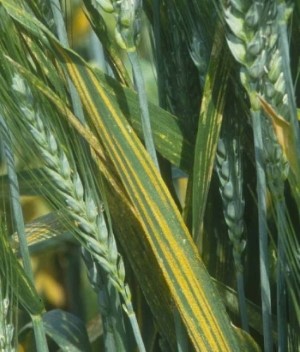
Varietal ratings relate to the combination of seedling (all stage) and adult plant resistance genes. The ratings are based on a variety's visual reaction to different pathotypes in replicated field experiments conducted across Australia annually under the NVT pathology system. This GRDC invested project then provides a national consensus rating each year. So, in essence, the disease rating relates to how a variety will react to stripe rust throughout the growing season.
How does resistance in a variety work and what is seedling resistance versus adult plant resistance?
Like animals, plants have evolved an immune system that protects them against invading pathogens. COVID-19 has taught us that animals (humans) can develop this immunity through exposure and vaccination. In plants however, this immunity is determined at "birth" and broadly speaking is based on genes that either:
- detect the presence of a pathogen and trigger a defence pathway (so called immune receptors). This resistance is usually effective at all growth stages and is known as all stage resistance (ASR; also referred to as 'seedling' or 'major' resistance). While very effective, ASR genes are those that are usually overcome by new rust pathotypes acquiring virulence.
- slow pathogen growth by 'starving' it. This resistance is effective at adult plant growth stages only and is known as adult plant resistance (APR; also referred to as minor gene resistance). APR is often durable, but incomplete in the protection it provides.
Where a variety only carries an ASR gene, and this is overcome by a new rust pathotype, its resistance rating may change from highly resistant to highly susceptible.
Adding another dimension of complexity, many wheat varieties carry a combination of ASR and APR genes. Having both these genes means a pathotypic change can result in a slight increase in susceptibility when the ASR gene is overcome by a new pathotype, but the APR gene is still effective in providing 'back-up' resistance.
New varieties have been impacted by stripe rust - has resistance broken down?
When a variety becomes more susceptible to stripe rust than previously experienced, it should be remembered that nothing has actually changed with the plants themselves. It is the pathogen that has changed. Either it has mutated to overcome a resistance gene, or a new exotic pathogen has been introduced. There is currently no evidence to indicate that what we have seen in 2021 is due to mutating or new pathotypes overcoming varietal resistances. Unexpected responses to stripe rust observed in some varieties this season is likely the result of a change in pathotype distribution (particularly an increase in 239) and climatic conditions (persistence of green bridge, earlier infections, multiple pathogen life cycles and slowed crop development). These factors are described in more detail in the other questions.
Why have varieties with the same rating been impacted to a different extent?

The actual pathotype infecting individual crops can have a significant impact on the level of stripe rust development. For example, when comparing Beckom, Scepter and Vixen (Table above) if sown as strips in an individual paddock they will behave quite differently depending on the actual pathotype present within the paddock. If the 134 pathotype is present, then Scepter will have more stripe rust development than either Beckom or Vixen as it is MSS to this pathotype whilst the other two varieties are MRMS.
However, if the 239 pathotype is present then Vixen will be impacted the most, followed by Scepter, whilst Beckom will appear quite clean. If the 198 pathotype is present, then all three varieties will have quite similar levels of infection. Note that more than one pathotype can infect an individual crop throughout the growing season with the 198 pathotype dominating early in both 2020 and in 2021, while the 239 and 134 pathotypes generally infected later in the season.
If the three varieties were to be grown in an area where the rare 64 pathotype was present, Vixen would display an SVS reaction, while Beckom and Scepter would appear quite clean. The variable rating for Vixen (MRMS/SVS) also shows if it is exposed to the 64 pathotype, disease has significantly greater potential to develop than if exposed to the other pathotypes.
How do I manage stripe rust?
Is it possible to see where stripe rust has been found?
Rust and pathotype distribution is mapped by the Australian Cereal Rust Laboratory throughout the season (Australian Cereal Rust Survey 2021 Sample Map - Google My Maps). There are a few weeks lag in identifying the actual pathotype but locations with variety details are mapped weekly after submission to the Australian Cereal Rust Survey and listed as 'result pending' until pathotype information is available.
Does knowing the pathotype change my in-season management?
This depends on your individual approach, as to whether you will take a worse-case scenario approach to stripe rust management based on a variety's reaction to dominant pathotypes in the previous season, or you wish to be more responsive in-season to timing and differential appearance of pathotypes in your area.
Will APR be enough?
Generally, if a variety has a level of stripe rust resistance below an MR rating then fungicide application is required to minimise stripe rust infection at earlier growth stages until APR is expressed. However, note that all varieties unless rated R are still susceptible to stripe rust infection as seedlings, which normally only occurs in seasons such as 2021 with early high disease pressure.
APR is a very useful control mechanism but if significant stripe rust infection exists within a crop when APR becomes active, this mechanism can strip significant green leaf area killing these existing infections. This is not the best way to use APR within varieties. Fungicide application is required at earlier growth stages to minimise infection levels around the time that APR is expressed so that this genetic protection becomes active without stripping out green leaf area.
When do I pull the trigger on fungicide applications?
There are a number of factors to consider when planning fungicide management strategies, but the aim remains to maximise retention of green leaf area on the top three leaves throughout the season to protect yield potential. Considerations when planning fungicide strategies include:
- observed level or predicted level of stripe rust pressure in crop or region;
- seasonal conditions in terms of recent/predicted rainfall and temperature which dictates infection events and disease cycle time;
- level of genetic resistance within a variety to different pathotypes and the corresponding need for protection at earlier growth stages (e.g. MRMS likely only requires a single fungicide at GS30 whilst MS requires fungicide at GS30 + GS39);
- nitrogen status of crop with high N crops having delayed APR expression and more conducive to infection;
- growth stage of crop and whether APR visually active and
- yield potential of crop as fungicide application is always an economic decision.
Like many crop inputs, predictions are that fungicide supplies may be tight or uncertain in 2022. This places more emphasis on variety selection for the coming season and growers should consider reducing the areas sown to stripe rust susceptible varieties which are reliant on fungicide intervention to protect yield potential. Increasing the area sown to more resistant varieties that are less reliant on multiple fungicide inputs appears worthy of consideration. This will be even more important if the 2021/22 summer is wet which will favour elevated green bridge carry-over of inoculum leading into the 2022 season.
Is the aim for the plant to be rust free?
Ideally crops should be managed to avoid significant development of spores within canopies so that fungicides are being used more in a preventative rather than curative approach to disease management. However, it is often impractical in high pressure seasons to expect every leaf to be totally clean. More important is whether the infections appear fresh (yellow and fluffy) or old (orange and drier) as spores can be visible and viable on leaves for 2-3 weeks until they desiccate. Is tissue death evident behind the pustules and is there flecking in leaves adjacent to hotspots or more heavily infected plants? This indicates that APR is active and infections although evident will not progress further.
Low levels of infection can still occur in MR or even MRMS varieties, but these will not significantly impact on yield so chasing totally rust free crops may not always be economical.
Grass weeds seem to be covered in rust – do they contribute to the problem?
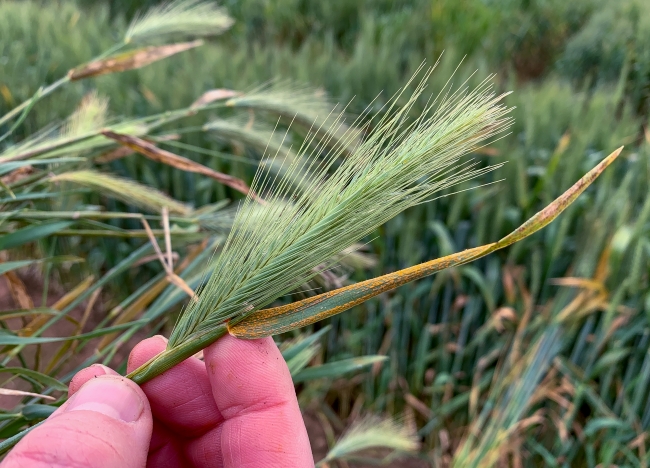
Potentially yes. Barley grass in particular was infected across most of the northern region with stripe rust in 2021. Barley grass can be infected by two types of stripe rust. This can be either 1) barley grass stripe rust, which does not infect wheat but can cause mild infection in some commercial barley varieties or 2) pathotypes of wheat stripe rust, which can contribute to additional disease pressure in wheat crops.
Rust came in late to the heads - does this impact yield or quality, and carry over in the seed?
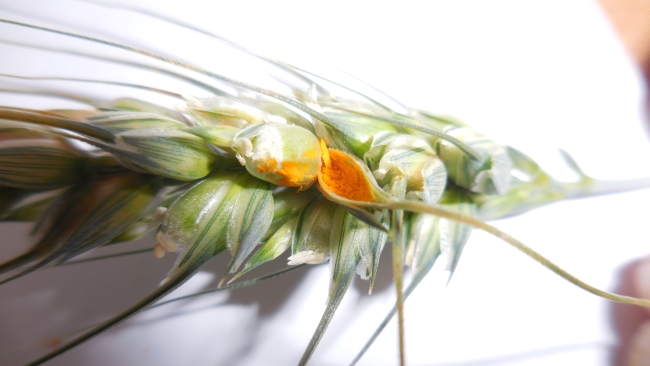
Stripe rust can infect individual spikelets within heads when spores enter through a gap created when the anthers (flowers) are exuded from the head. Hence, it is a fairly narrow period of infection that is unrelated to the level of genetic resistance within a variety. Head (glume) infection does not cause abortion of flowers but spores accumulate at the top of the developing grain and compete for resources. Glume infection can therefore reduce grain size within individual infected spikelets, while the rest of the grain within a head develops normally.
The impact on grain size is dependent on the amount of resources that the seed and stripe rust fungus are competing for during grain filling. In a softer prolonged grain fill period both the seed and pathogen are likely to obtain the resources they need, with minimal or no impact on grain size. Head infection does not carry over in the seed and spores will die or be less visible as the heads dry down into harvest, with any remaining spores blowing away during the harvest process.
In some situations, despite multiple fungicide applications, the disease seemed to keep progressing – is there fungicide resistance in stripe rust?
The University of Sydney Cereal Rust laboratory periodically conducts fungicide insensitivity testing of bulked up isolates from grower paddocks of the dominant pathotypes. There has been no evidence of fungicide insensitivity in the last three years but bulk testing of 2021 pathotypes will be conducted in early 2022 to confirm this is still the situation. There are a range of other potential explanations for the situation that was observed in 2021, including fungicide applications being applied outside the curative activity phase (if applied more than ~five days from infection, necrosis and pustule formation still occurs), vast difference between preventative vs curative approaches, rapid reinfection of crops from spores surviving 2-3+ weeks in hotspots and/or the pure quantity of spores blowing freely in the wind, and mild temperatures extending time between growth stages and therefore increasing the length of time that leaves were unprotected by fungicide in traditional fungicide strategies.
Many paddocks were too wet to use a ground rig. Does the application method make much difference to the level of control?
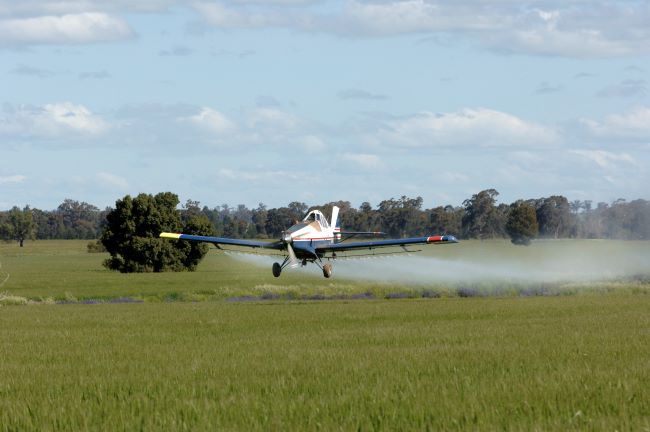
Potentially. As the saying goes 'coverage is king' when it comes to fungicide protection. Ground rigs allow higher water rates to be used and generally provide greater canopy penetration than aerial applications. Aerial applications are also inhibited by structures within paddocks such as trees and power lines, which can result in some areas simply not being able to receive coverage. Stripe rust can continue to cycle within these unsprayed areas and potentially provide a source of inoculum for more rapid reinfection of the crop once the fungicide protection wanes. Ground rigs generally do a better job of even application across all areas sown within a paddock.
Am I likely to see stripe rust again in 2022, and if so, what do I do?
The amount of inoculum in the landscape and predictions of a wet summer suggest that stripe rust could be a problem again in 2022. Minimise early infections by managing green bridge over the summer and autumn period. Understand the level of resistance associated with the varieties you are growing and seek advice on appropriate fungicide strategies to ensure pathogen loads are kept low until such time APR can be fully expressed. Growers and agronomists can assist in on-going rust surveillance and research by being vigilant with paddock monitoring and submitting samples to the University of Sydney Australian Cereal Rust Survey.






